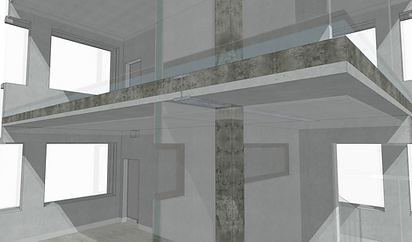
Hamburg
Klassenhäuser: Structure
Location
Hamburg
Comparing flexible slab constructions
Innovative solution
Otto Wulff / Ehoch3 / Hamburg University of Technology
Partners Involved
Schools
Building type
Concrete, Concrete/Steel Hybrid and Concrete/Timber Hybrid
Structural material
Structural system
Flat slabs supported on beams, columns and walls
Description
In Hamburg most schools are currently being built using traditional construction methodology of in situ concrete construction. With an increased need for additional schools, it is expected that faster construction progress could be achieved with the use of alternative construction and flexible connections. This would also result in economic and ecological advantages.
As part of CIRCuIT three alternative slab construction approaches has been studied to investigate the potential for a more circular approach to schools using the real project ‘Klassenhäuser’ with the ambition to complete 25 modular schools by 2030. As part of the assessment for this demonstrator four cases were studied.
Case 1 (BAU): In situ concrete slab construction
Case 2: Prestressed hollow concrete slab on delta steel beam, with concrete sealed connections.
This system has pre-stressed concrete slabs which have hollow bodies in the statically irrelevant areas. This reduces the dead weight and the construction can be made slimmer overall. In addition, a special steel beam (“delta beam”) can be used to support the slabs in the centre, which is flush with the ceiling and therefore does not create any height differences on the underside of the ceiling. This makes the room layout and installation under the ceiling much easier. The joints between slabs and beams are filled with concrete, but can be cut open in the event of dismantling. The cut out concrete panels can be cropped and reused afterwards. This has already been proven by the manufacturer of the beams, Peicco, in a real test.
Case 3: Prestressed hollow concrete slab on delta steel beam, without concrete sealed connections
This system is the same as Case 2, however the joints between slab and beam are filled with lime mortar instead of concrete making the dismantling process easier as it can be ‘washed away’ with high pressure.
Case 4. Concrete slab with timber beams, all screwed and bolted connections
The fourth system was developed to check whether a further reduction in the use of concrete and replacement with wood is possible and would bring benefits in terms of the circular economy and the GWP. Here, the load-bearing structure is a system of reinforced concrete beams to which second-order timber beams are connected. The ceiling slab is a maximally thin pre-fabricated concrete slab that is screwed onto the wooden beams. This is a system approved by the building authorities and can be dismantled very easy, because all connections are screwed and can be disconnected easily. But the construction results in a significantly higher ceiling structure resulting in much higher overall building costs.
Whilst all proposed alternative systems to the BAU case indicated high potential for reusability and material recovery, Case 2 was the most feasible solution based on impact on cost, floor to ceiling height and programme. The chosen alternative system for the built project was therefore Case 2, a hybrid system with pre-stressed concrete slabs supported by steel beams.
Demonstrated innovation
-
Compared to BAU all demonstrated slab systems can be disassembled without creating any mixed waste, allowing for either reuse or high value recycling.
-
All demonstrated slab systems results in less use of materials (the amount of concrete for the demonstrator floor slabs is 40% compared to the in-situ concrete construction)
-
The hybrid system of Case 2 using pre-stressed slabs and delta beams resulted in cost efficient results and further material savings from reduced floor to ceiling height.
Activities done
-
Three alternative approaches to slab construction for modular schools was developed compared to in-situ concrete construction as BAU
-
The impact of different construction methods was investigated. The impact of these on individual building elements as well as the impact on the entire building was considered.
-
A complete BIM model of all 3 alternative construction methods was created to investigate the impacts and quantity changes of the building materials.
-
The digital model was analysed with BIM quantity take-offs.
-
The components were evaluated for dissassembly and reusability. Possible improvements to increase this was identified.
-
Data collection for environmental and economic assessment was structured and conducted
Demonstrated impacts
The alternative slab construction studies in the demonstrator allows for full recovery of the materials either for reuse or high value recycling. The reason for this is that each element can be separated so that no mixed waste arises from demolition or deconstruction.
All of the alternative slab systems studies resulted in cost savings already in the first iteration. This is a result of the material savings associated with the proposed systems which used hollow concrete slabs instead of insitu.
The alternative systems studied resulted in 80% reusability rate for Case 2 and 90% reusability rate for Case 3 and 4. For Case 2 which was the chosen solution for the project, the improved reusability rate over two iterations could equate to 68% cost savings and 61% energy savings.

Case 1 (BAU)

Case 2 & 3 Prestressed hollow core concrete slab on delta beam (chosen)

Case 4 Concrete slab on timber beams



